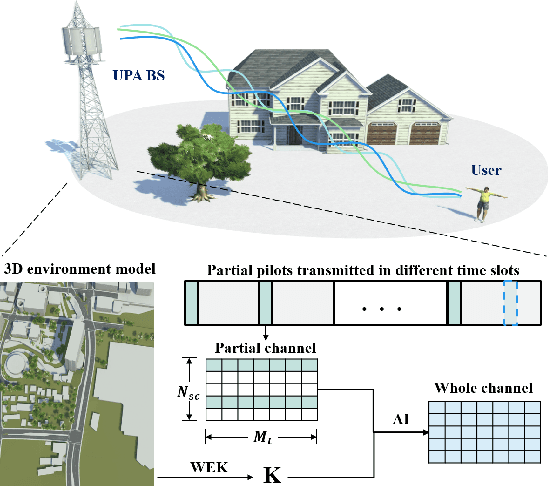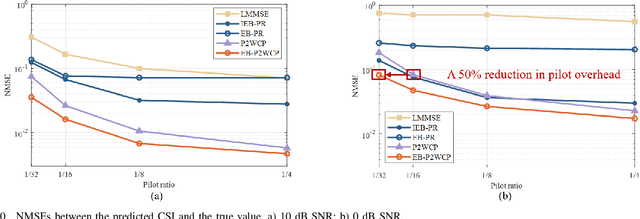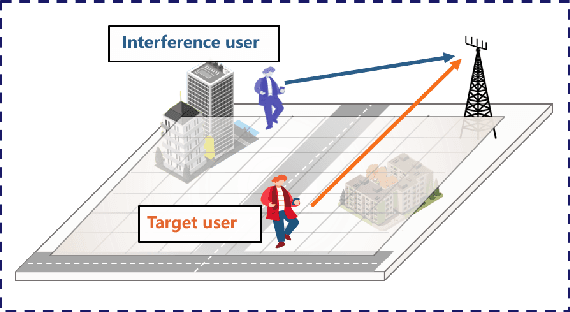Yichen Cai
Digital Twin Channel-Aided CSI Prediction: A Environment-based Subspace Extraction Approach for Achieving Low Overhead and Robustness
Aug 07, 2025



Abstract:To meet the robust and high-speed communication requirements of the sixth-generation (6G) mobile communication system in complex scenarios, sensing- and artificial intelligence (AI)-based digital twin channel (DTC) techniques become a promising approach to reduce system overhead. In this paper, we propose an environment-specific channel subspace basis (EB)-aided partial-to-whole channel state information (CSI) prediction method (EB-P2WCP) for realizing DTC-enabled low-overhead channel prediction. Specifically, EB is utilized to characterize the static properties of the electromagnetic environment, which is extracted from the digital twin map, serving as environmental information prior to the prediction task. Then, we fuse EB with real-time estimated local CSI to predict the entire spatial-frequency domain channel for both the present and future time instances. Hence, an EB-based partial-to-whole CSI prediction network (EB-P2WNet) is designed to achieve a robust channel prediction scheme in various complex scenarios. Simulation results indicate that incorporating EB provides significant benefits under low signal-to-noise ratio and pilot ratio conditions, achieving a reduction of up to 50% in pilot overhead. Additionally, the proposed method maintains robustness against multi-user interference, tolerating 3-meter localization errors with only a 0.5 dB NMSE increase, and predicts CSI for the next channel coherent time within 1.3 milliseconds.
Making Acoustic Side-Channel Attacks on Noisy Keyboards Viable with LLM-Assisted Spectrograms' "Typo" Correction
Apr 15, 2025Abstract:The large integration of microphones into devices increases the opportunities for Acoustic Side-Channel Attacks (ASCAs), as these can be used to capture keystrokes' audio signals that might reveal sensitive information. However, the current State-Of-The-Art (SOTA) models for ASCAs, including Convolutional Neural Networks (CNNs) and hybrid models, such as CoAtNet, still exhibit limited robustness under realistic noisy conditions. Solving this problem requires either: (i) an increased model's capacity to infer contextual information from longer sequences, allowing the model to learn that an initially noisily typed word is the same as a futurely collected non-noisy word, or (ii) an approach to fix misidentified information from the contexts, as one does not type random words, but the ones that best fit the conversation context. In this paper, we demonstrate that both strategies are viable and complementary solutions for making ASCAs practical. We observed that no existing solution leverages advanced transformer architectures' power for these tasks and propose that: (i) Visual Transformers (VTs) are the candidate solutions for capturing long-term contextual information and (ii) transformer-powered Large Language Models (LLMs) are the candidate solutions to fix the ``typos'' (mispredictions) the model might make. Thus, we here present the first-of-its-kind approach that integrates VTs and LLMs for ASCAs. We first show that VTs achieve SOTA performance in classifying keystrokes when compared to the previous CNN benchmark. Second, we demonstrate that LLMs can mitigate the impact of real-world noise. Evaluations on the natural sentences revealed that: (i) incorporating LLMs (e.g., GPT-4o) in our ASCA pipeline boosts the performance of error-correction tasks; and (ii) the comparable performance can be attained by a lightweight, fine-tuned smaller LLM (67 times smaller than GPT-4o), using...
Wireless Environmental Information Theory: A New Paradigm towards 6G Online and Proactive Environment Intelligence Communication
Dec 16, 2024Abstract:The channel is one of the five critical components of a communication system, and its ergodic capacity is based on all realizations of statistic channel model. This statistical paradigm has successfully guided the design of mobile communication systems from 1G to 5G. However, this approach relies on offline channel measurements in specific environments, and the system passively adapts to new environments, resulting in deviation from the optimal performance. With the pursuit of higher capacity and data rate of 6G, especially facing the ubiquitous environments, there is an urgent need for a new paradigm to combat the randomness of channel, i.e., more proactive and online manner. Motivated by this, we propose an environment intelligence communication (EIC) based on wireless environmental information theory (WEIT) for 6G. The proposed EIC architecture is composed of three steps: Firstly, wireless environmental information (WEI) is acquired using sensing techniques. Then, leveraging WEI and channel data, AI techniques are employed to predict channel fading, thereby mitigating channel uncertainty. Thirdly, the communication system autonomously determines the optimal air-interface transmission strategy based on real-time channel predictions, enabling intelligent interaction with the physical environment. To make this attractive paradigm shift from theory to practice, we answer three key problems to establish WEIT for the first time. How should WEI be defined? Can it be quantified? Does it hold the same properties as statistical communication information? Furthermore, EIC aided by WEI (EIC-WEI) is validated across multiple air-interface tasks, including CSI prediction, beam prediction, and radio resource management. Simulation results demonstrate that the proposed EIC-WEI significantly outperforms the statistical paradigm in decreasing overhead and performance optimization.
Wireless Environment Information Sensing, Feature, Semantic, and Knowledge: Four Steps Towards 6G AI-Enabled Air Interface
Sep 28, 2024



Abstract:The air interface technology plays a crucial role in optimizing the communication quality for users. To address the challenges brought by the radio channel variations to air interface design, this article proposes a framework of wireless environment information-aided 6G AI-enabled air interface (WEI-6G AI$^{2}$), which actively acquires real-time environment details to facilitate channel fading prediction and communication technology optimization. Specifically, we first outline the role of WEI in supporting the 6G AI$^{2}$ in scenario adaptability, real-time inference, and proactive action. Then, WEI is delineated into four progressive steps: raw sensing data, features obtained by data dimensionality reduction, semantics tailored to tasks, and knowledge that quantifies the environmental impact on the channel. To validate the availability and compare the effect of different types of WEI, a path loss prediction use case is designed. The results demonstrate that leveraging environment knowledge requires only 2.2 ms of model inference time, which can effectively support real-time design for future 6G AI$^{2}$. Additionally, WEI can reduce the pilot overhead by 25\%. Finally, several open issues are pointed out, including multi-modal sensing data synchronization and information extraction method construction.
Can Wireless Environmental Information Decrease Pilot Overhead: A CSI Prediction Example
Aug 13, 2024



Abstract:Channel state information (CSI) is crucial for massive multi-input multi-output (MIMO) system. As the antenna scale increases, acquiring CSI results in significantly higher system overhead. In this letter, we propose a novel channel prediction method which utilizes wireless environmental information with pilot pattern optimization for CSI prediction (WEI-CSIP). Specifically, scatterers around the mobile station (MS) are abstracted from environmental information using multiview images. Then, an environmental feature map is extracted by a convolutional neural network (CNN). Additionally, the deep probabilistic subsampling (DPS) network acquires an optimal fixed pilot pattern. Finally, a CNN-based channel prediction network is designed to predict the complete CSI, using the environmental feature map and partial CSI. Simulation results show that the WEI-CSIP can reduce pilot overhead from 1/5 to 1/8, while improving prediction accuracy with normalized mean squared error reduced to 0.0113, an improvement of 83.2% compared to traditional channel prediction methods.
Visual Imitation Learning of Task-Oriented Object Grasping and Rearrangement
Mar 20, 2024Abstract:Task-oriented object grasping and rearrangement are critical skills for robots to accomplish different real-world manipulation tasks. However, they remain challenging due to partial observations of the objects and shape variations in categorical objects. In this paper, we propose the Multi-feature Implicit Model (MIMO), a novel object representation that encodes multiple spatial features between a point and an object in an implicit neural field. Training such a model on multiple features ensures that it embeds the object shapes consistently in different aspects, thus improving its performance in object shape reconstruction from partial observation, shape similarity measure, and modeling spatial relations between objects. Based on MIMO, we propose a framework to learn task-oriented object grasping and rearrangement from single or multiple human demonstration videos. The evaluations in simulation show that our approach outperforms the state-of-the-art methods for multi- and single-view observations. Real-world experiments demonstrate the efficacy of our approach in one- and few-shot imitation learning of manipulation tasks.
 Add to Chrome
Add to Chrome Add to Firefox
Add to Firefox Add to Edge
Add to Edge